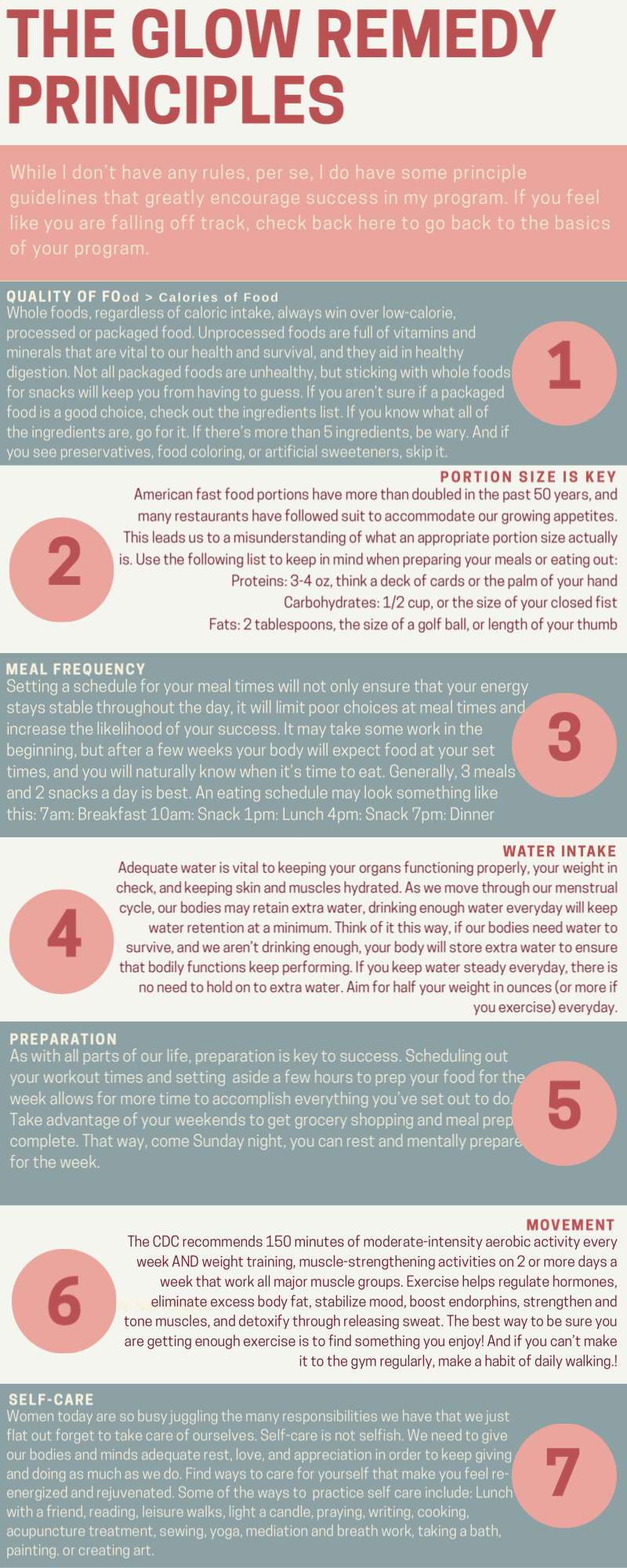THE GLOW REMEDY PRINCIPLES
THE GLOW REMEDY PRINCIPLES ARE THE GUIDELINES I USE WITH ALL OF MY CLIENTS. I CREATED THESE PRINCIPLES WHEN I STARTED MY COACHING PRACTICE AS A MEANS TO GIVE SOME DIRECTION WITHOUT MAKING MY CLIENTS FEEL TRAPPED BY A RESTRICTIVE DIET PLAN OR PLAGUED IN GUILT AND SHAME ABOUT OCCASIONALLY EATING FOODS THEY DEEMED AS “BAD” OR MISSING A WORKOUT.
IN THIS JOURNEY TO WELLNESS, REMEMBER THAT THE THINGS YOU DO MOST OF THE TIME ARE WHAT REALLY MATTER, NOT THE THINGS YOU DO SOME OF THE TIME.
BELOW ARE THE GLOW REMEDY PRINCIPLES. YOU CAN ALSO DOWNLOAD THE INFOGRAPHIC AT THE BOTTOM OF THE PAGE (CLICK TO DOWNLOAD) TO KEEP ON HAND AS A REFERENCE GUIDE. AFTER READING THROUGH THE PRINCIPLES, BE SURE TO ANSWER THE QUESTIONS IN YOUR WORKBOOK.
Quality of Food > Calories of Food
Whole foods, regardless of caloric intake, always win over low-calorie, processed or packaged food. Unprocessed foods are full of vitamins and minerals that are vital to our health and survival. They also aid in healthy digestion, due to the high fiber content. Not all packaged foods are unhealthy, but sticking with whole foods for snacks will keep you from having to guess. If you aren’t sure if a packaged food is a good choice, check out the ingredients list. If you know what all of the ingredients are, go for it. If there’s more than 5 ingredients, be wary. And if you see preservatives, food coloring, or artificial sweeteners, skip it.
Portion Size is Key
American fast food portions have more than doubled in the past 50 years, and many restaurants have followed suit to accommodate our growing appetites. This leads us to a misunderstanding of what an appropriate portion size actually is. I created the following list to keep in mind when preparing your meals or eating out:
-Proteins: 3-4 oz, the size of a deck of cards or the palm of your hand
-Carbohydrates: 1/2 cup, or the size of your closed fist
-Fats: 2 tablespoons, the size of a golf ball, or the equivalent of the length of your thumb.
Meal Frequency
Setting a schedule for your meal times will not only ensure that your energy stays stable throughout the day, it will limit poor choices at meal times and increase the likelihood of your success. It may take some work in the beginning, but after a few weeks your body will expect food at your set times, and you will naturally know when it’s time to eat. So how often should you be eating? Generally, 3 meals and 2 snacks a day is best.
An eating schedule may look something like this:
7am: Breakfast
10am: Snack
1pm: Lunch
4pm: Snack
7pm: Dinner
Water Intake
Adequate water is vital to keeping your organs functioning properly, your weight in check, and keeping skin and muscles hydrated. As we move through our menstrual cycle, our bodies may retain extra water, drinking enough water everyday will keep water retention at a minimum. Think of it this way, if our bodies need water to survive, and we aren’t drinking enough, your body will store extra water to ensure that bodily functions keep performing. If you keep water steady everyday, there is no need to hold on to extra water. Aim for half your weight in ounces (or more if you exercise) everyday. For example, if you weigh 150 pounds drink at least 75 ounces of water.
Preparation
As with all parts of our life, preparation is key to success. Scheduling out your workout times and setting aside a few hours to prep your food for the week allows for more time to accomplish everything you’ve set out to do. Take advantage of your weekends to get grocery shopping and meal prep complete. That way, come Sunday night, you can rest and mentally prepare for the week.
Movement
The CDC recommends the following minimum requirements of physical activity just to reach the health benefits of exercise:
150 minutes of moderate-intensity aerobic activity (i.e., brisk walking) every week (roughly 20 minutes a day) AND weight training, muscle-strengthening activities on 2 or more days a week that work all major muscle groups.
Exercise helps regulate hormones, eliminate excess body fat, stabilize mood, boost endorphins, strengthen and tone muscles, and detoxify through releasing sweat. The best way to be sure you are getting enough exercise is to find something you enjoy! This is so important! You will not be motivated to exercise if you don’t enjoy what you are doing. I encourage you to step outside of your comfort zone and try something new, you never know what might be your new favorite form of movement! if you can’t make it to the gym regularly, make a habit of daily walking. Walks are hugely under appreciated for movement and hormone regulation. some new ideas include: Self-defense, martial arts, rock climbing, yoga, cycling, strength training or power lifting, dance classes, roller skating, ice skating, trampoline or rebounder, swimming, pilates, Zumba, barre, boxing!
Self-Care
The most undernourished part of health that I see in my clients is self-care. Women today are so busy juggling the many responsibilities we have that we just flat out forget to take care of ourselves. Self-care is not selfish. We need to give our bodies and minds adequate rest, love, and appreciation in order to keep giving and doing as much as we do.Find ways to care for yourself that make you feel re-energized and rejuvenated. Some of the ways to practice self care include: Lunch with a girlfriend, reading, sitting near water (river, ocean), treating yourself to a spa treatment (massage, facial or mani/pedi), leisure walks, light a candle, praying, writing, pamper yourself at home with a homemade face mask or essential oil body treatment, cooking, acupuncture treatment, sewing, yoga, mediation and breath work, adult coloring books, zentangles, playing with your pet, taking a bath, painting. or creating art.
